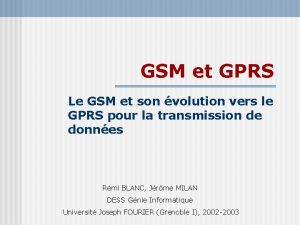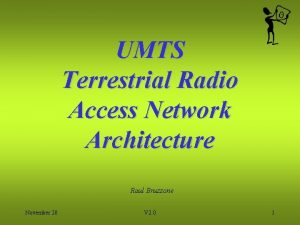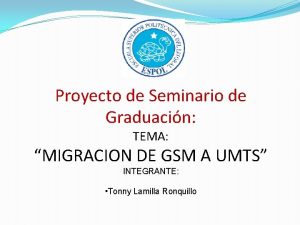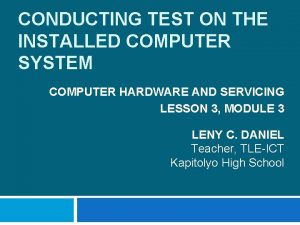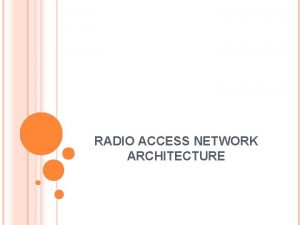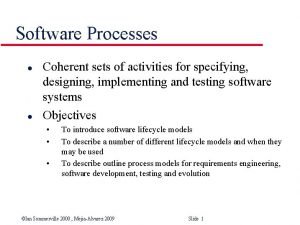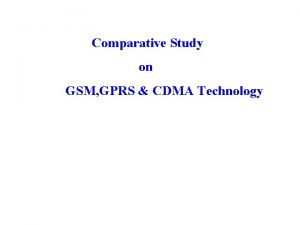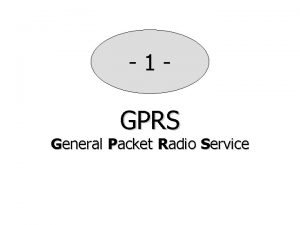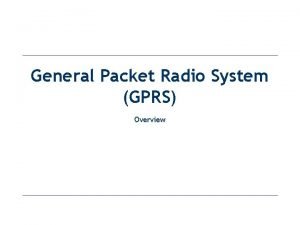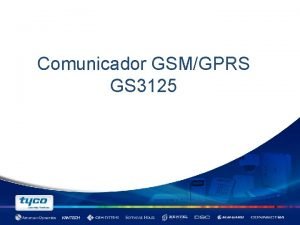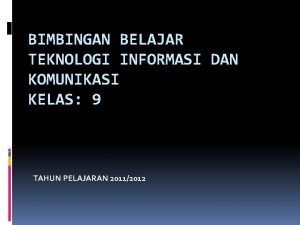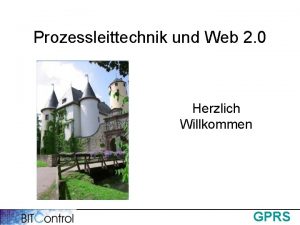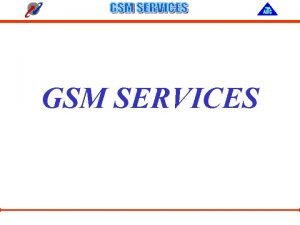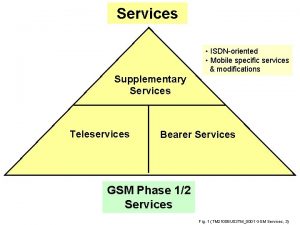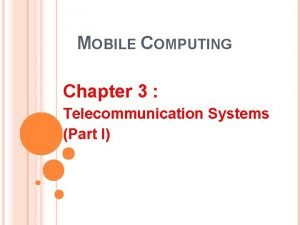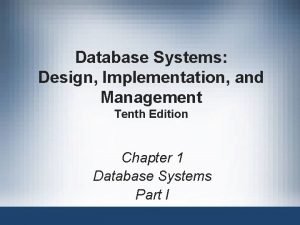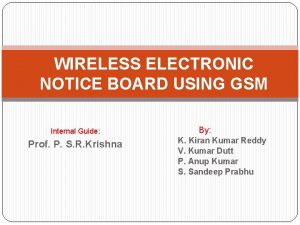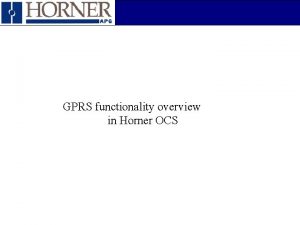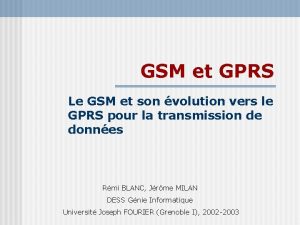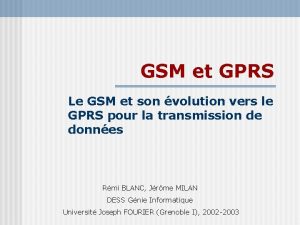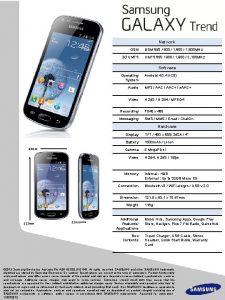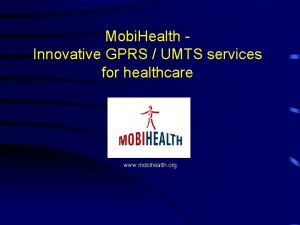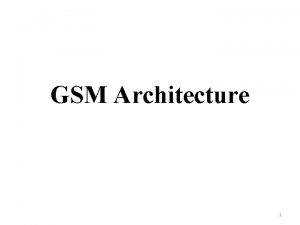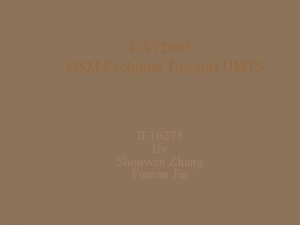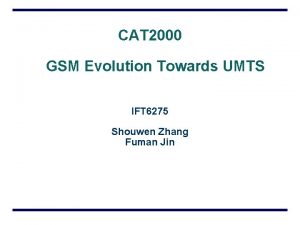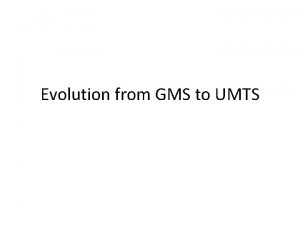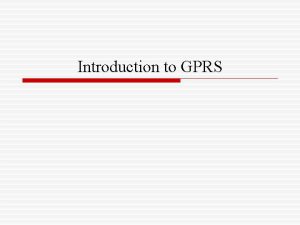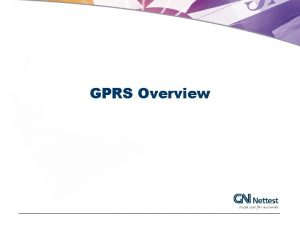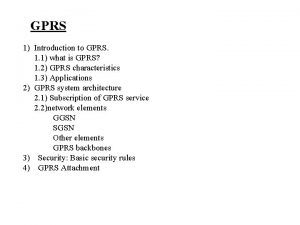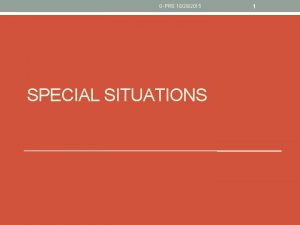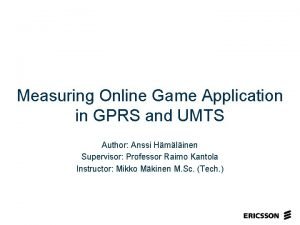GSM Data evolution Functionality UMTS GSM GPRS services



























- Slides: 27

GSM Data evolution Functionality UMTS GSM GPRS services upto 160 kbit/s PDS services low bit rates GSM HSCSD services upto 38. 4 kbit/s (later up to 64 kbit/s) GSM CS data services upto 9. 6 kbit/s © Sunrise 91/92 98 99/00 02 EDGE

GPRS evolution towards 3 rd Generation HSCSD “High Speed Circuit Switched Data” Ø 1 st step in GSM Phase 2+ that clearly increase achievable data Rates in the GSM System Ø 14. 4 kbps Channel Coding =115. 2 kbps for 8 Tsl ØMaximum data rate is limited to 64 kbps due to CN a A-Interface limitation q. Precondition: §Modify GSM Network to support HSCSD in BSC & MSC §Handsets has to support Multislot Capabilities §Today HSCSD (Data Cards)Handsets support 4 Tsl in Downlink and up to 2 Tsl in Uplink Direction © Sunrise

GPRS evolution towards 3 rd Generation ØDepending on the Cell Configuration amount of Users is restricted ØMultiple User cannot share a Tsl at the Air Interface ØDepending on the Bearer Nature “Circuit Switched” a Tsl is dedicated to a Subscriber ØAmount of Subscriber per Tsl is limited to 1 ØCircuit Switched Data has a long access time ØCall Charging is based on connection time © Sunrise

GPRS evolution towards 3 rd Generation GPRS “General packet Radio System” © Sunrise ØConnections do not reserve resources permanently, which is ØHighly efficient for applications with a bursty nature ØShort access time to the Network ØCharging model can be based on transmitted volume ØGPRS brings packet switched bearer services to the existing GSM System ØUser can Access Public Data Network directly using their Standard protocol addresses (IP, X. 25) ØGPRS Mobile can use between 1 -8 channels over the air interface depending on the MS capabilities

GPRS evolution towards 3 rd Generation q. Resource allocation is dynamic and dependent on demand Resource Availability q. Packets can be sent on idle time between speech call depending MS class types q. Possible traffic types § point to point § point to multipoint (postponed to Release 4&5) § SMS capability § Anonymous access (planned) q. Maximum Theoretical throughput per MS using 8 Tsl without Error Correction is 160 kbps © Sunrise

GPRS Logical Architecture SMS-GMSC SMS-IWMSC E SM-SC C Gd MSC/VLR MT R Gb BSS Um D Gs A TE HLR Gc Gr SGSN Gp Gi PDN GGSN Gn Gf EIR GGSN Other PLMN © Sunrise Signaling Interface Signaling and Data Transfer Interface TE

ISDN/ PSTN GPRS Logical Architecture Um GMSC MSC/VLR BTS Notebook & GPRS mobile Gb AUC Gr Gs BSC Gf EIR HLR External IP Network SGSN Gn Traffic & Signaling BTS - Base Transceiver Station BSC - Base Station Controller MSC - Mobile Switching Centre HLR - Home Location Register SGSN - Serving GPRS Support Node GGSN - Gateway GPRS Support Node PTM-SC - Point-to-Multipoint Service Centre © Sunrise IP-Backbone Network PTM-SC GGSN Gi External IP Network External X. 25 Network

GPRS Network Node Functionality • SGSN and GGSN are IP based packet switching nodes • SGSN supports basic mobility management, session management, subscription checking, charging • GGSN supports session management, charging and provides interconnect points to ISPs (Internet Service Provider) • BSC (PCU) supports the Radio Link- and Medium Access Control protocol (RLC/MAC) • BTS supports new channel coding and interleaving • HLR supports subscriber data management © Sunrise

GPRS Mobiles • Class A: Simultaneous usage of Circuit- and Packet switched services (2 TRX=Dual Transfer Mode DTM is precondition). • Class B: Automatic choice of service, Circuit- or Packet switched, but only one at a time (1 TRX). Suspension/resumption of GPRS services at setup/release of CS connection. • Class C: Manually selected use of either Circuit- or Packet switched service. Special case is a packet only MS (1 TRX). © Sunrise

GPRS Mobile Station “Multislot Classes” Class © Sunrise 1 2 3 4 5 6 7 8 9 10 11 12 13 14 15 16 17 18 19 20 21 22 23 24 25 26 27 28 29 Download Upload 1 2 2 3 3 4 4 4 3 4 5 6 7 8 6 6 6 8 8 8 1 1 2 2 3 4 5 6 7 8 2 3 4 4 6 8 Max. slots 2 3 3 4 4 4 5 5 5 unlimited unlimited unlimited unlimited unlimited

GPRS Transmission Plan Application IP / X. 25 SNDCP GTP LLC UDP/ TCP RLC BSSGP IP IP MAC Frame Relay L 2 GSM RF L 1 bis L 1 MS © Sunrise IP / X. 25 Um BSS (PCU) Gb SGSN Gn GGSN Gi

GPRS Routing <->Transmission Plane © Sunrise

GPRS Handset IP Address Assignment ØMobile User connects to specified APN ØAPN is configured in the GGSN ØKinds of Handset IP address assignment üGGSN pool per APN Subscriber IP Address assignment üexternal DHCP Server üIntranet DHCP Server üFixed IP Address Assignment in the HLR per Subscriber and APN (not or!!) © Sunrise

GPRS Routing and Address Plan IPv 4 ‣used In GPRS Backbone (public & private) ‣used for Handsets (public & private) IPv 6 ‣Backbone can support with Release 99 implementation ‣current used GPRS capable Handsets does not support IPv 6 ‣ 1 st steps visible for UMTS Handsets only © Sunrise

GPRS Routing and Address Plan Further necessary Routing Instrument for GPRS ØTLLI=Temporary Logical Link ID ØRouting Area ØLocation Area © Sunrise

GPRS Routing and Address Plan Gb Interface SGSN<->BSC Gn Interface SGSN<->GGSN Handset IP TLLI Tunnel ID =IMSI BVCI /LA/RA © Sunrise GTP Address

Avoid Collision at the Air Interface Data Transmission divided in to Up- and Downlink Data Traffic © Sunrise

GPRS Multiplexing at RLC/MAC Layer © Sunrise

GPRS Coding Schemes based on RLC/MAC © Sunrise

GPRS Quality of Service Profile 1) Delay for packets of 128 octets; • Delay class 1 (mean 0. 5 sec, 95% < 1. 5 sec) • Delay class 2 (mean 5 sec, 95% < 25 sec) • Delay class 3 (mean 50 sec, 95% < 250 sec) • Delay class 4 (unpredicted) 2) Reliability • Reliable data transfer (retransmission, delay) • Unreliable data transfer (no retrans. , small delay) • Unreliable data transfer, erroneous data discarded (no retrans. , small delay, data loss) © Sunrise

GPRS Quality of Service Profile 3) Priority Ø Priority class 1 (highest priority) • Priority class 2 • Priority class 3 • Priority class 4 (lowest priority) • 4) Mean and 5) Peak throughput © Sunrise

GPRS Roaming Direct Interconnect © Sunrise

GPRS Roaming using IPSEC Tunnel via Internet © Sunrise

GPRS Roaming using GRX © Sunrise

GPRS Roaming Scenario using HGGSN © Sunrise

GPRS Roaming Scenario using VGGSN © Sunrise

further Steps ØPacket Handling (PBCCH/PCCCH) ØQo. S Negotiation (Air <->GGSN) ØIncreasing USF Granularity ØIPv 6 ØNetwork Mode Changes to decrease MS signalling ØMS with higher Multislot Capabilities ØExtended MAC Modes ØTechnology §EDGE GPRS with 8 PSK modulation §UMTS © Sunrise
 Architecture du gprs
Architecture du gprs Wcdma network architecture
Wcdma network architecture Arquitectura umts
Arquitectura umts Which of the following is not a data mining functionality?
Which of the following is not a data mining functionality? Loopback
Loopback Ranap protocol stack
Ranap protocol stack Evolutionary software process models
Evolutionary software process models Sgb functionality tool
Sgb functionality tool Jquery functionality
Jquery functionality For full functionality
For full functionality Gprs stands for: *
Gprs stands for: * Gprs architecture
Gprs architecture Gprs cdma
Gprs cdma Gprs
Gprs Gprs overview
Gprs overview Gs3125 software download
Gs3125 software download Kepanjangan dari gprs adalah.... *
Kepanjangan dari gprs adalah.... * Gprs stands for
Gprs stands for Gprs architecture
Gprs architecture Sgsn stands for
Sgsn stands for Gsm services and features
Gsm services and features Supplementary services in gsm
Supplementary services in gsm Gsm protocol
Gsm protocol Evolution of financial services
Evolution of financial services Evolution of file system data processing
Evolution of file system data processing Diffserv vs intserv
Diffserv vs intserv Wake county human services community services center
Wake county human services community services center Wireless electronic notice board using gsm
Wireless electronic notice board using gsm
